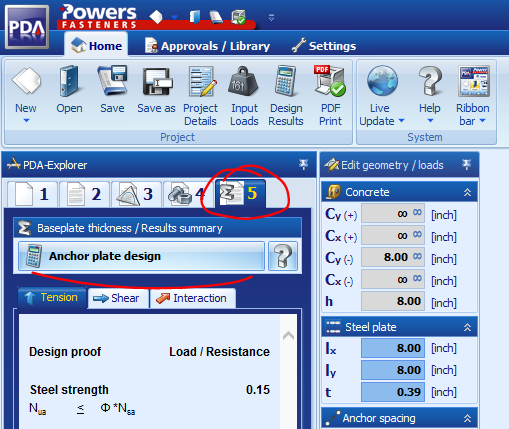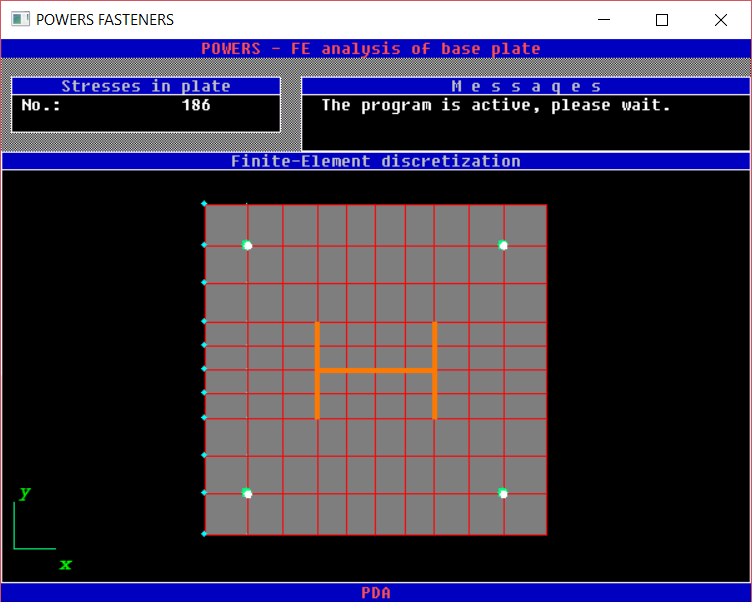Does anyone know of any good (and free!) cast-in-place anchor calculation templates and/or programs? I'm looking for applications in both piers and in slab on grade. Hilti's PROFIS Anchor program seams to leave out some breakout checks and I'm not sure how Powers PDA program holds up.
Navigation
Install the app
How to install the app on iOS
Follow along with the video below to see how to install our site as a web app on your home screen.
Note: This feature may not be available in some browsers.
More options
Style variation
-
Congratulations MintJulep on being selected by the Eng-Tips community for having the most helpful posts in the forums last week. Way to Go!
You are using an out of date browser. It may not display this or other websites correctly.
You should upgrade or use an alternative browser.
You should upgrade or use an alternative browser.
Cast-In-Place Anchor Template or Program
- Thread starter acwooten
- Start date
- Status
- Not open for further replies.
EngineeringEric
Structural
What does Hilti Leave out?
Simpson also makes one.
Simpson also makes one.
TehMightyEngineer
Structural
I use Powers PDA exclusively for cast-in-place anchor design. The calculations by the program are easy to verify. I usually only run a hand calc these days if I have an unusual geometry or anchor situation that Powers doesn't cover.
Professional Engineer (ME, NH, MA) Structural Engineer (IL)
American Concrete Industries
Professional Engineer (ME, NH, MA) Structural Engineer (IL)
American Concrete Industries
I only use Hitli's Profis for post-install anchors. I made my own spreadsheet for Appendix D checks for cast in place anchors. The calcs are difficult at first, but once you've done them a few times, you start to get the hang of it.
TME, I've never heard of that one. I'll have to check it out.
TME, I've never heard of that one. I'll have to check it out.
TehMightyEngineer
Structural
@Winelandv: Yeah, check it out for sure. Obviously keep you spreadsheet up to date too but Powers is nice when you need to spit out a bunch of low-load cast-in bolt calculations. Plus they include a fairly powerful FEA baseplate design tool which I haven't fully verified but appears to be quite accurate. Overall it's a powerful free program.
jayrod12 is also right that Simpson's program does a great job as well. The reason I personally use Powers PDA over Simpson is our precast plants use Powers products for all our epoxy anchor systems.
Professional Engineer (ME, NH, MA) Structural Engineer (IL)
American Concrete Industries
jayrod12 is also right that Simpson's program does a great job as well. The reason I personally use Powers PDA over Simpson is our precast plants use Powers products for all our epoxy anchor systems.
Professional Engineer (ME, NH, MA) Structural Engineer (IL)
American Concrete Industries
- Thread starter
- #7
EngineeringEric,
I'd have to go back in and look at what exactly it left out. And it may have changed, since the last time I checked it (about 2 years ago). All I remember was that it was a concrete breakout check.
winelandv,
Would you be opposed to sending me the excel file you've created for the checks? I'd love to have a jump start on creating my own.
TehMightyEngineer,
Are you saying The Powers PDA does that baseplate check or Powers has an additional program that does it? I haven't noticed that the PDA does a baseplate check if it does.
Thanks for the comments y'all.
I'd have to go back in and look at what exactly it left out. And it may have changed, since the last time I checked it (about 2 years ago). All I remember was that it was a concrete breakout check.
winelandv,
Would you be opposed to sending me the excel file you've created for the checks? I'd love to have a jump start on creating my own.
TehMightyEngineer,
Are you saying The Powers PDA does that baseplate check or Powers has an additional program that does it? I haven't noticed that the PDA does a baseplate check if it does.
Thanks for the comments y'all.
acwooten,
I'm going to refrain from distributing my spreadsheet - it's definitely in a beta state, and hasn't been thoroughly vetted for all the possible situations/geometries that can arise.
Also, I found that going through and putting the App D equations into the spreadsheet really helped me understand App D much better.
I'm going to refrain from distributing my spreadsheet - it's definitely in a beta state, and hasn't been thoroughly vetted for all the possible situations/geometries that can arise.
Also, I found that going through and putting the App D equations into the spreadsheet really helped me understand App D much better.
TehMightyEngineer
Structural
acwooten, see below. Also, look in the Powers PDA help file for a great description of the equations used and the checks they make.


Professional Engineer (ME, NH, MA) Structural Engineer (IL)
American Concrete Industries


Professional Engineer (ME, NH, MA) Structural Engineer (IL)
American Concrete Industries
I prefer Hilti Profis because I find it to be the easiest to use. I haven't noticed breakout checks being omitted unless you check that there is anchor reinforcement present to eliminate concrete breakout. If you check that box then the checks go away. You will have to manually design the reinforcement and check that your anchor embedment is adequate.
bootlegend
Structural
This thread made me curious so I downloaded the Powers program to compare to Hilti Profis. I've attached output from each program for the same situation involving cast in place anchors. Can anyone explain what is going on with the shear steel strength with a lever arm in the Powers output? All other checks appear to align between the two programs. It appears that Powers is using a much larger lever arm and larger flexural resistance for the anchor.
Note: Looks like I can only attach one file per post so I'll post the second file below.
Note: Looks like I can only attach one file per post so I'll post the second file below.
bootlegend
Structural
Second file mentioned above is attached here.
TehMightyEngineer
Structural
Powers designs the lever arm per ETAG 001 Annex C. As Powers PDA is programmed for both European and US usage I would guess they default to the more conservative check. That said, it appears to be roughly the same calculations.
Looking in the help file, Powers appears to add in the baseplate (fixure) thickness which Hilti does not from what I can tell. Otherwise it appears they should be calculating Lb the same and getting roughly similar numbers for the capacity. Overall I'd say it's an error (or there's something hidden in the black box we are missing).
I'm going to actually email Powers about this as I don't think there should be such a drastic difference between the two.
Edit: See above, dylansdad has the answer. Your baseplate thickness is set to 75 inches. 50% of this thickness = 37.5 inches and the source of the discrepancy.
Professional Engineer (ME, NH, MA) Structural Engineer (IL)
American Concrete Industries
Looking in the help file, Powers appears to add in the baseplate (fixure) thickness which Hilti does not from what I can tell. Otherwise it appears they should be calculating Lb the same and getting roughly similar numbers for the capacity. Overall I'd say it's an error (or there's something hidden in the black box we are missing).
I'm going to actually email Powers about this as I don't think there should be such a drastic difference between the two.
Edit: See above, dylansdad has the answer. Your baseplate thickness is set to 75 inches. 50% of this thickness = 37.5 inches and the source of the discrepancy.
Professional Engineer (ME, NH, MA) Structural Engineer (IL)
American Concrete Industries
bootlegend
Structural
dylansdad said:Let me start by saying I am not up to speed on either of these programs, but is the Powers program considering a 75 inch base plate?
Looks like that was the case. Appears you have to enter the leading zero as in 0.75". No leading zero and it doesn't recognize the decimal. I guess that's what happened and I didn't catch it in the printed output.
Worth noting that it also doesn't scale the baseplate thickness graphically like the Hilti program does. Can't dummy proof it for everyone but it would have helped me catch the mistake.
- Status
- Not open for further replies.
Similar threads
- Locked
- Question
- Replies
- 31
- Views
- 6K
- Locked
- Question
- Replies
- 3
- Views
- 2K
- Locked
- Question
- Replies
- 4
- Views
- 2K
- Locked
- Question
- Replies
- 17
- Views
- 5K
- Replies
- 13
- Views
- 15K

![[smile] [smile] [smile]](/data/assets/smilies/smile.gif)